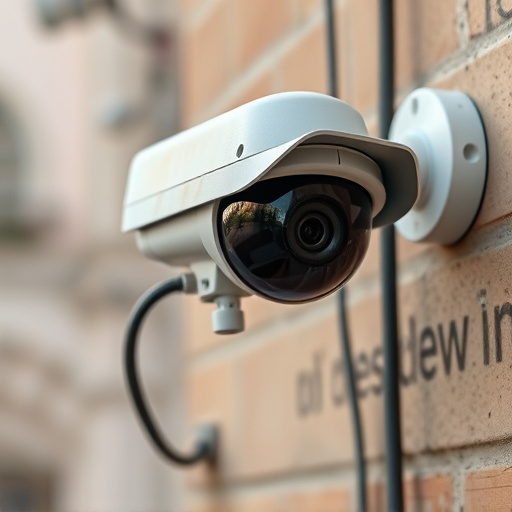The Fake Security Camera Angle Guide emphasizes strategic dummy camera placement for maximum deterrence. By targeting high-risk areas like entry points and valuable assets, these cameras create an illusion of constant observation, reducing crime rates. Technical considerations, such as angle and field of view adjustments, ensure effective coverage. Authenticity is enhanced with props and regular maintenance to mimic genuine security measures, making the setup a cost-efficient, powerful deterrent.
“Boost your home or business security with our expert guide on dummy surveillance camera placement. Understanding the psychology behind where to position these fake cameras can deter criminals effectively. This comprehensive article navigates choosing high-risk areas visible to potential threats, technical tips for optimal angle and field of view, and accessorizing tips to enhance realism. Discover the Fake Security Camera Angle Guide to create a convincing deterrent without breaking the bank.”
- Understanding the Psychology Behind Dummy Camera Placement
- Choosing the Right Location: High-Risk Areas and Visibility
- Technical Considerations for Optimal Angle and Field of View
- Enhancing Realism: Accessorizing and Maintaining Your Fake Surveillance Setup
Understanding the Psychology Behind Dummy Camera Placement
Understanding the psychology behind dummy surveillance camera placement is a crucial step in deterring potential criminals. These fake security cameras serve as a powerful visual deterrent, manipulating would-be thieves’ behavior and decision-making processes. By strategically positioning them at angles that mimic real camera views, you create an illusion of constant observation. This can significantly reduce crime rates, as offenders are more likely to avoid areas where they believe they’re being watched.
The Fake Security Camera Angle Guide plays a vital role in achieving this effect. It involves carefully considering factors like line of sight, coverage area, and the camera’s field of view. For instance, placing dummy cameras at intersection points or blind spots can maximize their effectiveness. Additionally, aligning them to mimic real camera feeds encourages offenders to change their tactics or opt for less risky targets, thereby enhancing overall security.
Choosing the Right Location: High-Risk Areas and Visibility
When choosing the right location for a dummy surveillance camera, understanding high-risk areas is paramount. These are places where crime is more prevalent or where valuable assets require extra protection. For instance, entry points like doors and windows, as well as areas with expensive equipment or sensitive information, should be top priorities. The placement should offer clear visibility to deter potential criminals, making it look like an actual security system is in place.
The Fake Security Camera Angle Guide suggests positioning the camera at a strategic angle that covers these high-risk zones while maintaining a natural field of view. This visual deterrent can significantly enhance security without requiring extensive resources. By carefully selecting locations with both high-risk potential and good visibility, you maximize the effectiveness of your dummy surveillance setup.
Technical Considerations for Optimal Angle and Field of View
When placing dummy surveillance cameras, understanding technical considerations is key to achieving optimal angle and field of view (FOV). The camera’s placement should align with the desired coverage area, ensuring a wide FOV captures enough detail without overlapping or missing crucial zones. Angle adjustments are critical; positioning cameras at a slight downward tilt helps prevent blind spots on the ground, while a diagonal angle can offer enhanced peripheral vision.
In terms of Fake Security Camera Angle Guide, keeping the camera’s horizon parallel to the area being monitored ensures consistent and accurate footage. Additionally, adjusting the lens’ focal length can manipulate the FOV; wider angles are ideal for broader areas but may distort distant objects, while telephoto lenses provide a narrower view with enhanced detail at longer ranges. These technical nuances enable users to tailor their dummy surveillance setup for maximum effectiveness.
Enhancing Realism: Accessorizing and Maintaining Your Fake Surveillance Setup
To enhance realism with your dummy surveillance camera setup, consider accessorizing beyond just the cameras themselves. Adding relevant props like a security sign or two, reflective decoys, and even artificial power cables can fool viewers into believing they’re observing an actual security system. Regular maintenance is also key; dust off the cameras and props periodically to keep them looking authentic.
Remember, the fake security camera angle guide isn’t just about placement; it’s about creating a believable narrative. Aim for diversity in angles—high, low, and at eye level—to mimic real-world surveillance patterns. This inconsistency will make your setup harder to identify as fake, adding layers of realism to your deception.
When setting up dummy surveillance cameras, understanding human behavior, choosing strategic locations, and considering technical aspects like angle and visibility are key. By following these tips, you can create a realistic fake security camera setup that deters crime and adds an extra layer of protection to your property. Remember, the goal is not just placement but creating an environment where potential intruders feel watched, acting as a powerful deterrent in your Fake Security Camera Angle Guide.
